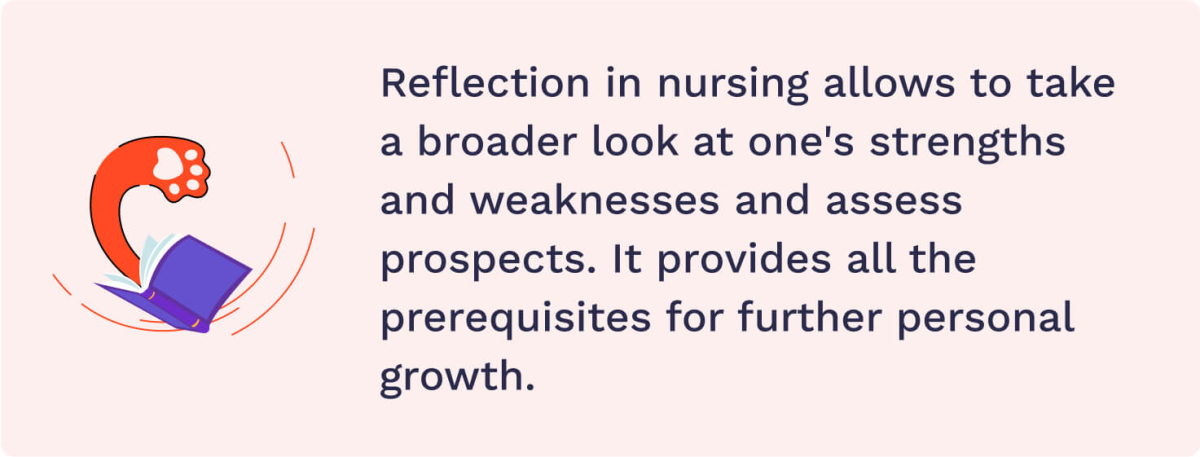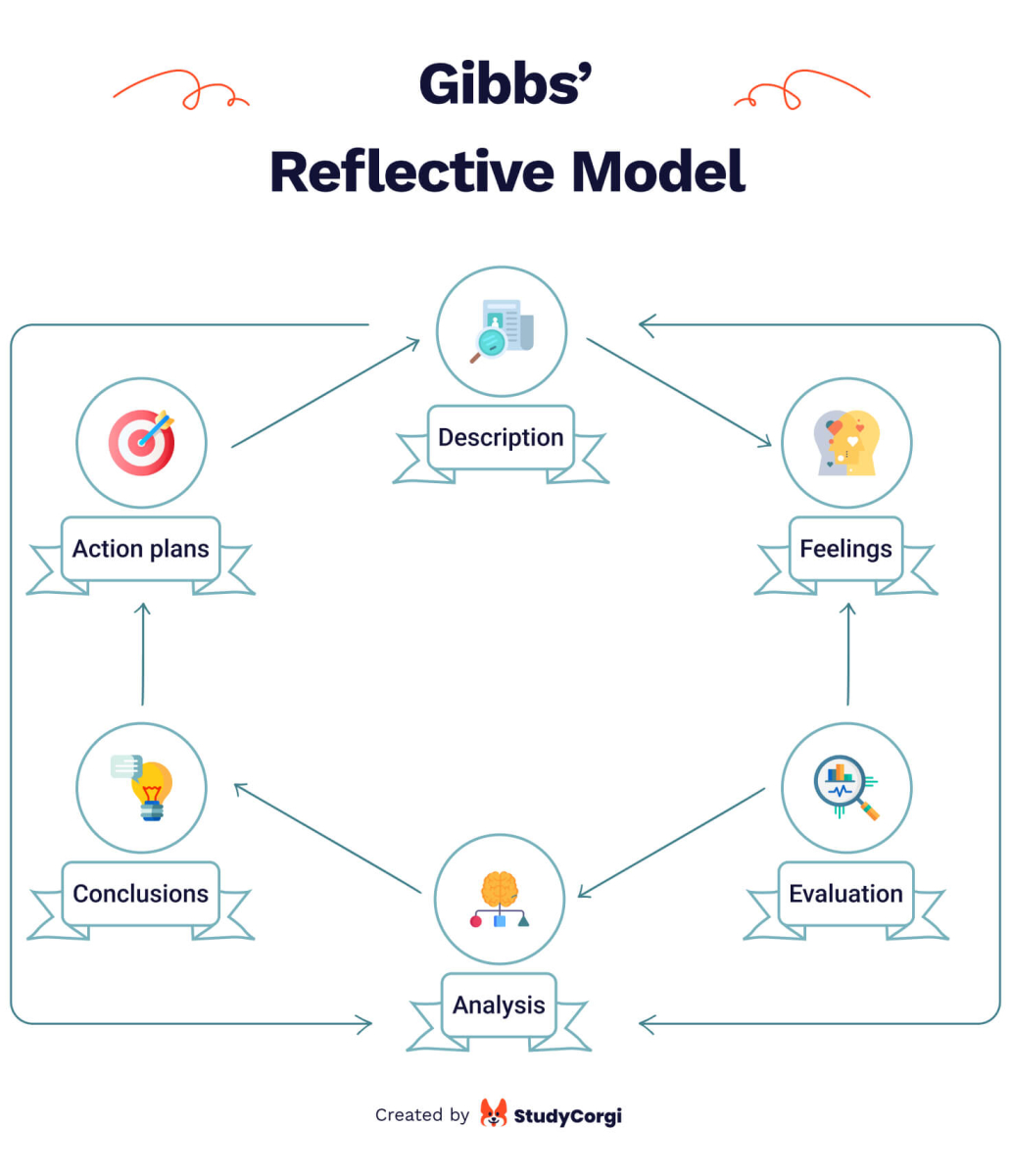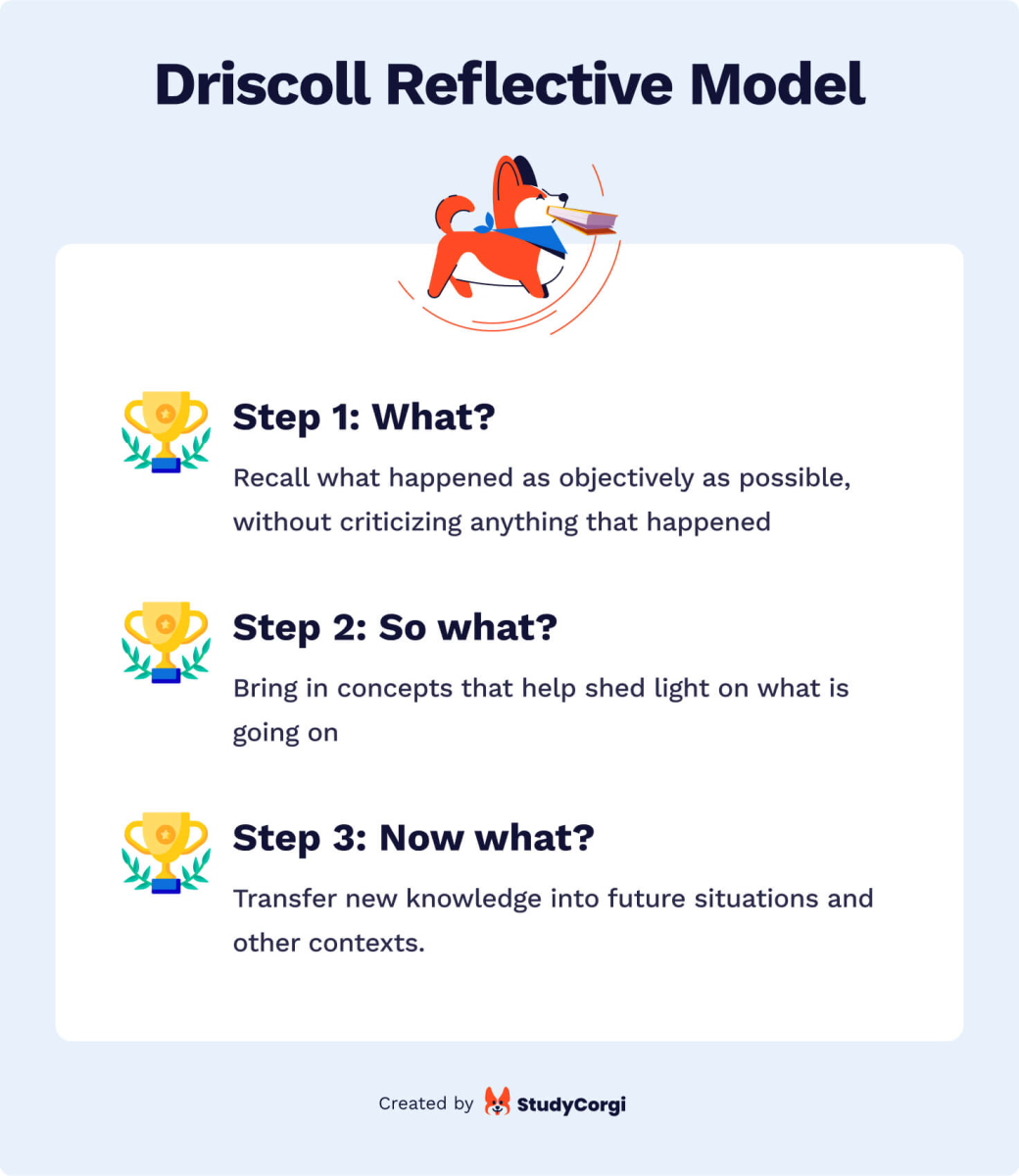Do you need to write a reflective nursing essay? Whether you are a nursing student or already working, we know that you may be too busy writing papers. We’ve prepared information for you about reflection models and nursing reflective essay examples, writing instructions, and templates for the outline. This article will teach everything you need to make writing your essay easier.
So, how do you write an academic reflective essay?
What Is a Reflective Essay?
In a reflective essay, you express your thoughts based on your knowledge, beliefs, reflections, and experiences. A reflective essay is best described as an exceptional and personal essay: you will have a lot to think about, comprehend, and explain. You have to demonstrate the feelings that you have experienced before. It should be honest. If you have any opposing thoughts and feelings about the topic, you should write them.
The peculiarity of a reflective essay, unlike an analytical one, is in the expression of thoughts based on personal experience.
How long does a reflective essay last? It’s simple. It depends on your topic and how you express your thoughts. But you have to remember that this is a highly brief type of essay, and you can do it with a few pages.
You can check out the 100% free essay samples to see it all.

What Is a Reflection in Nursing Essay?
Nursing involves many aspects of work, and reflection is one of the critical tools for developing professional competence and personal skills. In nursing, reflection is important because it provides all the prerequisites for further personal growth. It is a reflection that will allow you to take a broader look at your strengths and weaknesses and assess your prospects.
Think of your nursing reflective essay as a chance to reflect on your career, skills, and personality, which will lead to further improvement.
15 Best Reflective Essay Topics: Nursing
- Empathy and support in nursing.
- Communication with patients is one of a nurse’s most important tasks.
- Nursing is the art of caring for the patient during illness.
- The key is not to cause harm but to help afterward.
- Time management in nursing.
- The Patient’s Interests Come First.
- Why did I become a nurse?
- Doctor-patient confidentiality in nursing.
- The importance of enhancing soft skills for the nurse.
- Nursing knowledge should not be limited to narrowly professional information.
- Reflective essay on the internship.
- Nursing culture and ethics.
- Deontology of nursing and its synthesis with my personal experience.
- Nursing clinical reflection essay.
- Nursing issues for the elderly.
Nursing Reflective Essay Examples
To better understand what reflexivity is, let’s look at examples based on these articles:
Reflective Tools and Models
Scientists from different fields of science invented many models to simplify the process of reflection. Below are reflection models you can use in your essay nursing writing practice.

Gibbs’ Reflective Model
In 1998, Graham Gibbs introduced his reflexive model to the world. Gibbs’ model is a cycle and, therefore, excellent for analyzing repetitive experience.
It covers 6 stages:
- Description. What happened? Don’t judge or try to conclude yet; just describe.
- Feelings. What were your reactions and emotions? Again, don’t begin to analyze them yet.
- Evaluation. What was good or bad about the experience? Make value judgments.
- Analysis. Were different people’s experiences similar or different in importance?
- Conclusions. What conclusions can you draw in a general sense from this experience and your analysis? What conclusions can you draw about your particular, unique personal situation or way of working?
- Personal action plans. What steps are you going to take based on what you have learned? What are you going to do differently in this situation next time?
Dewey’s Reflective Thinking Model
John Dewey believed that reflective thinking is the active, persistent, and careful evaluation of a belief or assumed form of knowledge, the grounds for that knowledge, and the additional conclusions to which knowledge leads.
John Dewey’s Reflective Model was one of the first and has been the foundation for many other models. He identified five steps of reflective thinking:
- Step 1: Identify the problem.
- Step 2: Investigate the issue.
- Step 3: Generate several possible solutions.
- Step 4: Evaluate the options and select the best answer from the combination of solutions.
- Step 5: Test and implement the solution.
Kolb Reflective Model
The Kolb Reflective Model or “Kolb cycle” focuses on transforming information into knowledge. The basic four steps of the Kolb model are as follows:
- Concrete experience. Anyone should already have experience in the field or area they want to learn.
- Observation and reflection. This stage implies analyzing the person’s experience and knowledge.
- Forming abstract concepts. A model describing the information and expertise is built at this stage. Ideas are generated, interrelations are made, and new information is added concerning how everything works and is arranged.
- Testing in new situations. The last stage implies experimentation and testing the model’s applicability and concept. The result of this stage is a direct unique experience. Then the circle closes.
Schön Reflective Model
Donald Schön’s reflexive model was described in the book ‘The Reflexive Practitioner.’ He explained how professionals solve problems with a kind of improvisation that is perfected through practice.
Schön’s reflective model, like his writings, is based in many ways on the Dewey we already know
- Action reflection involves reflecting on an experience you have already had or an action you have already taken. It involves considering what could have been done differently and the positive aspects of that interaction.
- Reflection in action involves reflecting on your efforts as you make them and considering issues such as best practices throughout the process.
Bouds Reflective Model
David Bouds paired with Schön to explore the limits of reflective practice. This model is based on learning by doing. By analyzing his own experience, the practitioner begins to understand better how to improve certain things.
Bouds suggests that by reflecting, a person may be unconsciously learning. In reassessing the events of his life, he systematizes and classifies emotions, ideas, and results, as well as results, and compares past goals with results.
Past experiences, experiences, and ideas require constant analysis attention to feelings. This leads to new perspectives, commitment to action overall positive changes in behavior.

Driscoll Reflective Model
John Driskoll proposed a simple model of reflection at the beginning of the 21st century. It involves reflection through extended answers to questions we are already familiar with. The scholar linked the three basic questions to the stages of the experiential learning cycle and then added trigger questions that must be answered to complete the process of reflection.
Step 1: What? Sets out to recall what happened as objectively as possible, without criticizing anything that happened
Questions:
- What exactly happened?
- What exactly did you do?
- Was anyone else involved?
- Was it a good experience? Or a bad experience? Or both? And why?
Step 2: So what? It requires you to slow down and start looking for patterns or meaningful moments. The key here is to bring in concepts that help shed light on what is going on.
Questions:
- How did you feel at that particular moment?
- How did you react?
- Why did you react that way?
- Did you feel the same way about the situation then as you do now?
- Did you experience conflict with your values?
- Do you think past cases influenced your experiences in this situation?
- Who else was involved in the situation? How did they feel? And how did they react? And why did they react that way?
Step 3: Now what? Encourages beginning to transfer new knowledge into future situations and other contexts.
Questions:
- What did you learn from reflecting on this situation/experience/incident?
- Could you have prevented the negative consequences?
- And how might you have done so?
- What would you have done differently if a similar situation arose in the future?
- What could you have done to better prepare for it?
- Where did things go wrong last time, and what would you focus on now?
5R Framework
The 5R Framework was developed in 2002 by a group of scientists as a universal system of reflection, later modified.
It focuses on five basic steps, each addressing one aspect of reflection. Thinking through the five stages, an individual will engage all of the major reflection components, allowing you to create a critically meaningful review based on your experience.
- Report. What do you see and hear? Write it all down.
- React. What do you think is happening? What works well and what doesn’t? How do you feel about the situation you are reflecting on? What is it about this situation that makes you feel this way?
- Relate. How do my perceptions of this situation relate to my personal and professional experiences? How do they relate to my knowledge and skills? Through what “lens” do you view this situation? From the perspective of classroom management or collaborative learning? Do you need professional development in terms of content knowledge?
- Reason. Do you relate your point of view to someone else’s and how it affects the situation? Does sound practice support your strategies, or do you use different approaches? How does your point of view affect how you understand the problem? Could another point of view be helpful?
- Reconstruct. What did you learn from this observation, and how will it affect your practice?
CARL framework
The CARL framework of reflection involves going through four stages: context, action, results, and learning. The vastness of this model gives a lot of information, and even at the first stage, you can already get a lot of valuable data. But this is also its main disadvantage because it makes the model more complex.
The framework has four steps:
- Context: Description of the context of the experience.
- Action: Explanation of the action taken.
- Results: Explanation of what your actions led to.
- Learning: Identification of the experience and knowledge gained.
Reflective Essay Writing Tips
Now that we’ve covered the basic concepts let’s write a reflective nursing essay.
Reflective Essay Outline
How to make a reflective essay? First, write an outline.
Any reflective essay is a statement of thoughts about something, and the outline acts as a sketch in which you write them down. Creating it is the first step to creating high quality and vivid essay.
What would make a good outline structure for a reflection essay? Structure all your knowledge. Write what you want to see in the introduction, body, and conclusion.
Here is the reflective essay outline template:
- Introduction
- Hook: Use a catchy statement to set the tone and introduce the article.
- Mention the main points.
- Thesis statement: Include all the important points and ideas in one statement.
- Section 1
- Topic sentence: Carefully explain the first idea in one sentence.
- Proof of topic or idea: Use authoritative sources to support the idea.
- Idea analysis: Apply logic and rational thought to the idea and information from the source.
- Section 2
- Topic sentence: Carefully explain the second idea in one sentence.
- Proof of topic or idea: Use authoritative sources to support the idea.
- Idea analysis: Apply logic and rational thought to the idea and information from the source.
- Section 3
- Topic sentence: Carefully explain the third idea in one sentence.
- Proof of topic or idea: Use authoritative sources to support the idea.
- Idea analysis: Apply logic and rational thought to the idea and information from the source.
- Conclusion
- Repeat the statement of the thesis.
- Review the main ideas
- Final, concluding sentence
Reflective Essay Thesis
A thesis statement is a condensed version of the paper in which you must briefly explain your position. The point is for your audience to read it and understand your work.
To make a good thesis statement for a reflective essay, you need to formulate your thought on paper. To begin with, think well about the problem, and develop your attitude toward it. That’s why the thesis statement should be created after writing the outline. It is unnecessary to give everything out in advance to the reader because later, you will unfold this thought more broadly.
After successfully developing the thesis statement, you can proceed to the actual writing.
And so, below, you can see examples of the reflective essay introduction and conclusion. Learn what its body of it is.
How to Start a Reflective Essay? Examples
You need to start any paper in the right way. How to write a reflective essay introduction? Check these examples:
- Practice and theory do not always agree. Not all of the medical reference books that I have been able to study are fully applicable in practice. John Kimble’s case is a testament that it is often necessary to rely on them and consider the specific situation. He complained of dizziness, and the doctors advised him to get a blood iron test. The test showed that there was nothing wrong. But as it turned out later, this was an erroneous result because Kimble had eaten redfish rich in iron the day before, which temporarily raised the iron in his blood.
- I had always dreamed of becoming a nurse, but my fear of blood robbed me of all desire to study. But still, my passion and ambition made me pull my will into a fist. I had to change and forget what fear of blood was. I lived my dream, which helped me overcome one of my fears.
- A few years ago, I went through a severe emotional crisis. I had always dreamed of going to the University of California, as it is one of the most prestigious medical universities in the United States. But unfortunately, I failed my entrance exams, so I had to study at the university in my hometown. My failure seemed like a disaster, but now I realize it was a real blessing.
Reflective Essay Body Paragraphs
The essay’s body carries arguments, explanations of the topic, and the main body of information.
Each paragraph should begin with short introductory sentences, and the body of the sections should be divided into several parts. This will help you better structure what you have written and help the reader navigate through the text.
It is worth remembering about argumentation. There should be several things that you rely on in your position. Describe each of them in detail in a separate paragraph. Observe the semantic sequence. A mistake, in this case, will be to repeat twice the same argument in different words. It will give the reader the impression that there is nothing to say.
You should also remember about transitions in a reflective essay. Move smoothly from one aspect to another and take your time.
How to Conclude a Reflective Essay?
How to end a reflective essay? In conclusion, you should focus on pulling together all of the material, summarizing all of the points made and what you have learned. Try to include a few moments about why and how your attitudes and behaviors changed. Here are some examples:
- Was the practice of volunteer nursing helpful to me? Absolutely! I was grateful for these weeks because I learned a lot. But most of all, I have learned my Soft skills, which will help me get used to my professional activities.
- At that moment, I thought about who would be the priority in that situation, and I still believe it was the patient. If the same problem were to arise again, I think I would do nothing but speak up and justify my decisions. I recognize and know that time management and prioritization are essential skills in nursing, and I hope that my skills will improve with practice.
- I reflected on how personal values can affect professional practice from the incident. Still, it is crucial to consider that the organization has its own set of values to follow, regardless of personal values. Finally, in reflecting on the incident, I was able to discuss the importance of quality assurance monitoring and health care evaluation both in general and during the incident, which allowed me to consider what conclusions were drawn from the incident and how to prevent similar situations occurring again.
So, now you have examples and an idea for writing a reflective nursing essay. Writing your paper will become many times easier and faster.
If this article was helpful, share it with your friends and colleagues!
FAQ
❓ What Is the Purpose of Writing a Reflective Essay?
A reflective essay aims to express one’s thoughts about a previous experience, including how one changed in the process and what one learned. It is often described in a diary entry; they are intended to demonstrate how the author’s thoughts have changed over time.
❓ What Makes a Good Reflective Essay?
A reflective essay is a combination of both objective and subjective elements. We mix scholarly analysis with personal experiences. This type of paper should explain to readers how our experience influences our behavior and what lessons we learned.
❓ What Are the 3 Basic Parts of Reflection Paper?
An essay should have a clear structure and must contain three parts. It should have a clear introduction reflecting the problem, then the central part with an analysis of the causes, and the conclusion with possible solutions to the problem or how it affected the author.
❓ What Is the Best Reflective Model to Use in Nursing?
One of the best options for nurses is the Gibbs model. The model is accessible and extremely simple. Therefore it can be operated without any problems in any situation.
![Nursing Reflective Essay: Examples + Useful Writing Tips [2024]](https://studycorgi.com/wp-content/uploads/2022/04/medical-assistant-reading-book-elder-disabled-woman-nursing-home-senior-patient-sitting-wheelchair-receiving-assistance-support-from-nurse-as-entertainment-fun-activity-485x528.jpg)